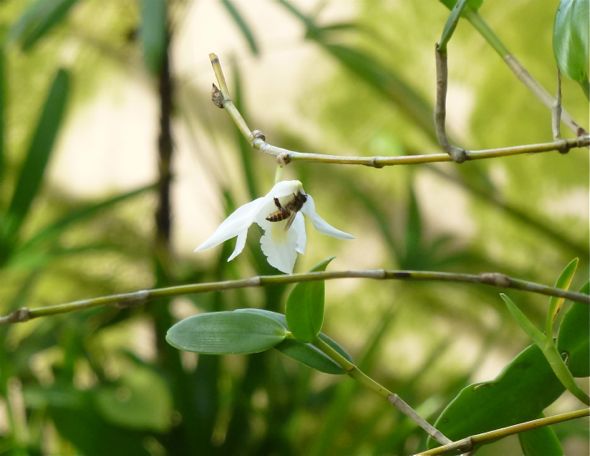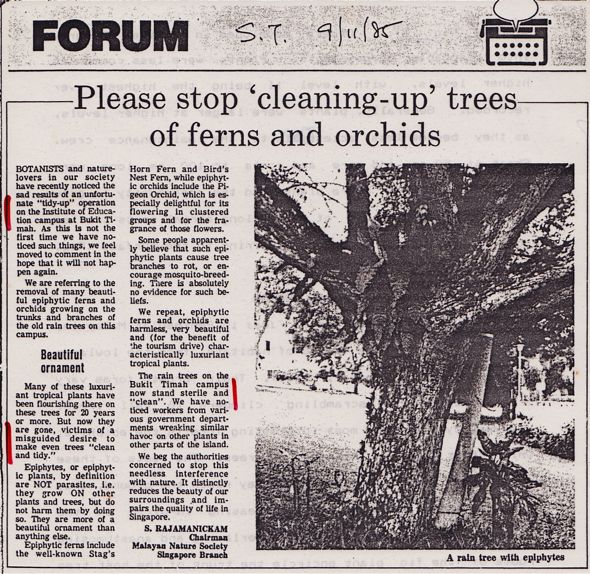I was in my garden on the morning of 25th March 2014 when I detected a peculiar smell in the air. The smell was familiar, yet unfamiliar. It was a little pungent and overpowering, as if something was burning. For a moment I thought it came from the nearby road where for the past six months and more, workers were busy constructing anti-ponding works – digging the road and drains… Then suddenly my attention was drawn to the bunch of Pigeon Orchids (Dendrobium crumenatum) growing on the lower trunk of my Terap tree (Artocarpus odoratissimus) (above).
Yes, the Pigeon Orchids were flowering profusely. There were at least 250 white flowers, coming from about 50 flowering stalks, each bearing 4-6 flowers. These flowers were filling the air with the unusual perfume, a perfume that smelled different from my previous encounters. About half an hour later the perfume turned to the usual smell that I am used to. As the day went by the perfume became less and less powerful. And the flowers began to fade.
It is generally accepted that a combination of a sudden drop of about 5ºC and hydration, brought about by heavy rain, lead to simultaneous flowering nine days later (Hew & Yong, 2004; Yam et al., 2010). The long drawn out drought Singapore experienced during February 2014 finally broke on 16th March with the first rain. Exactly nine days later, on 25th March, we had this spectacular flowering in my garden. And flowering is definitely not confined to this garden – it could be seen nearly all over Singapore.
The strong fragrance attracted honeybees (Apis cerana) in the early morning (above). During their multiple visits to the flowers, many ended up with a pollinium (a coherent mass of pollen grains in orchids) attached to their thorax. In this way the bees helped in the pollination of the flowers.
An earlier observation found a high rate of fruit formation (Leong & Wee, 2013) (above). Whether there was nectar reward for these bees has yet to be proven as many species of Dendrobium lack nectar (Leong & Wee, 2013). It has been suggested that the flowers make use of specific pollination strategies of deception and mimicry to attract the bees (Kjellsson et al., 1985).
Although Pigeon Orchids are commonly seen growing on many of our roadside trees, it was not so a few decades ago. Then, it was the standard practice to rip them off branches (together with other epiphytic ferns) in the mistaken belief that these plants damage the host trees (above). Happily in the early 1990s these orchids were attached to trees in an effort to make Singapore a fragrant city (below).
YC Wee
Singapore
March 2014
References:
1. Hew, C. S. & J. W. H. Yong, 2004. The Physiology of Tropical Orchids in Relation to the Industry. 2nd Edition. World Scientific Publishing Co. Pte. Ltd., Singapore. 370 pp.
2. Kjellsson, G., F. N. Rasmussen & D. Dupuy, 1985. Pollination of Dendrobium infundibulum, Cymbidium insigne (Orchidaceae) and Rhododendron lyi (Ericaceae) by Bombus eximius (Apidae) in Thailand: A possible case of floral mimicry. Journal of Tropical Ecology, 1: 289–302.
3. Leong, T. M. & Y. C. Wee, 2013. Observations of pollination in the pigeon orchid, Dendrobium crumenatum Swartz (Orchidaceae) in Singapore. Nature in Singapore 6: 91-96.
4. Yam, T. W., J. Chua, F. Tay & P. Ang, 2010. Conservation of the native orchids through seedling culture and reintroduction – A Singapore experience. Botanical Review, 76: 263–274.
5. Wee, Y. C., 2007. Memories. In: Lum, S. K. Y., H. T. W. Tan & Y. C. Wee (eds.), Trees of the Bukit Timah Campus: A Tribute to Old Friends. National University of Singapore and Nature Society (Singapore), Singapore. Pp.114–117.


![Dendrobium crumenatum fl [wyc] - 1](https://besgroup.org/wp-content/uploads/Dendrobium-crumenatum-fl-wyc-1.jpg)

![Dendrobium crumenatum 5d fr 1+1x0.4 cm [wyc] - 1](https://besgroup.org/wp-content/uploads/Dendrobium-crumenatum-5d-fr-1+1x0.4-cm-wyc-1.jpg)








